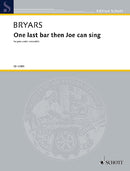| 作曲者 | Gavin Bryars (b. 1943) |
| タイトル | One last bar then Joe can sing |
| サブタイトル | A Homage to Deagan for percussion ensemble |
| 出版社 | Schott・ショット |
| 楽器編成 | percussion-Quintett |
| 楽器編成(詳細) | Percussion 1: Crotales (with bow),Chocolo,Mark Tree,Percussion 2I: Song Bells (with bow),Chinese Cymbal,3 Wood Blocks,Percussion 3: 2 Cymbals,2 Triangles,Xylophone,Marimba (shared with Marimba II),Vibraphone (with bow),Percussion 4: 2 Cymbals,2 Gongs,Marimba I (with low F),Maracas,Percussion 5: 2 low Tom-Toms,Marimba II (to low A) |
| 品番 | 9790220118142 |
| 形状 | 60 ページ・中綴じ |
| 演奏時間 | 20分 |
| 作曲年 | 1994年 |
| 出版年 | 1997年 |
| 出版番号 | ED 12585 |
| ISMN | 9790220118142 |
One Last Bar Then Joe Can Sing (1994) was commissioned by the Arts Council of Great Britain for the percussion quintet Nexus, and is a reflection on aspects of percussion history, both personal and musical. The members of Nexus are my friends (I played in the Steve Reich Ensemble along with Russ Hartenberger in 1972, the year after Nexus was formed). The piece aimed to demonstrate how a fine percussion ensmeble can be as musically expressive and subtle as, say, a string quartet. The piece starts from the last bar at the end of the second act of my opera Medea, a very short coda for a quintet of untuned percussion instruments during which the curtain falls. In this piece, however, this one apparently innocuous measure is progressively fragmented until it is taken over, little by little, by the addition of tuned percussion instruments. Eventually two metallophones (crotales and songbells) play aria-like material with bows, occasionally joined by the xylophone, and accompanied by marimba and xylophone ostinati. The piece ends with a coda in which phrases are passed from bowed vibraphone to bowed crotales, then to bowed songbells, supported by tremolos on the marimbas. The rare 3-octave songbells that Nexus owns is one of the American instrument maker J. C. Deagan's particularly fine instruments. The piece is effectively a kind of homage to Deagan, the Stradivarius of the tuned percussion world, who collaborated closely with Percy Grainger in the development of tuned percussion music between the wars. The allusions in the title are obvious: the one last bar is the last measure of music from my opera, the song is that of Deagan's songbells. In the case of Joe I wanted to link my father, Joe Bryars (who was a good amateur baritone singer) with Joseph Deagan and his songbells. However, some time after I had written the piece, Nexus's Bob Becker took me to one side and told me (gently) that the initial J in Deagan's name, in fact, stood for JohnGavin Bryars



